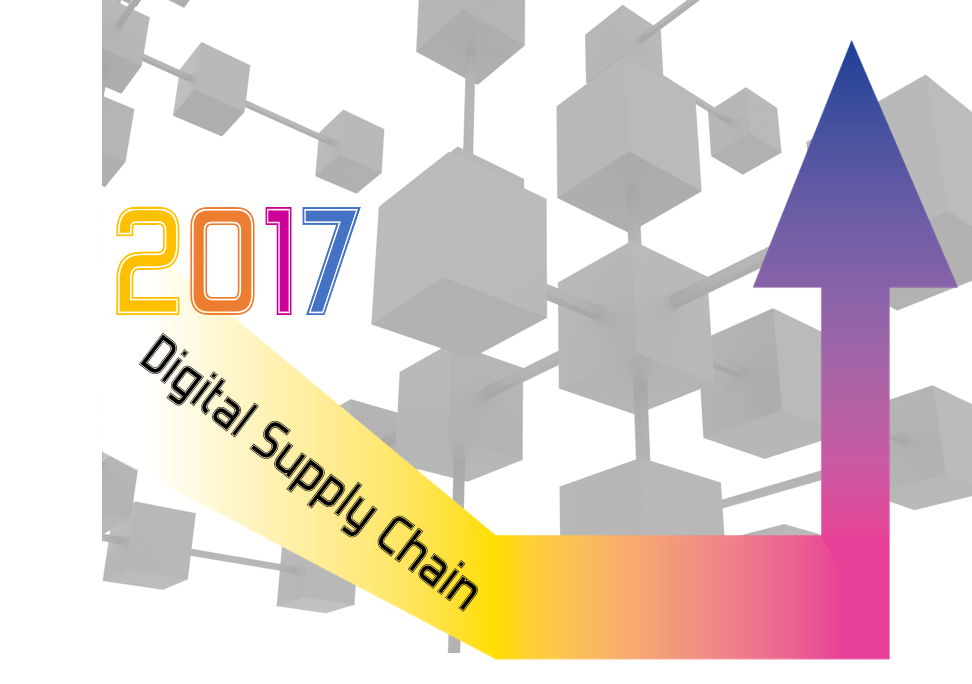Looking back what might historians have to say about 2017? It depends, of course, on whether you are looking at the year from a political, economic, climatological, retail, scientific, or some other perspective. As anyone who has ever attended a sporting event knows, where you sit often determines what you see. From the supply chain perspective, 2017 may be seen as the turning point for the digital supply chain. Alan Amling (@alan4logistics), vice president of corporate strategy at UPS, writes, “The fourth industrial revolution is here, spurred by digital technologies that promise to optimize supply chains and accelerate innovation. Whether you call it supply chain digitization, Internet of Things, or Industry 4.0, all require a ‘smarter’ supply chain — connected devices, connected assets, and masses of data turned into actionable insights.”[1]
Disruption and the Digital Supply Chain
Disruption is a curse word in the supply chain world. If supply chain professionals were more superstitious, they might have created a euphemism for the term, much like actors refer to Shakespeare’s MacBeth as “the Scottish Play” rather than risk disaster by uttering the name MacBeth inside a theater. The irony of digital supply chain transformation is that it is simultaneously a disruptor and a mitigator of disruption. Digital transformation, like any transformation, is disruptive because it changes how things are accomplished. The old order is shown the door as a new order is introduced. Change is almost always difficult and a little contentious so change agents need to keep the bigger picture in mind. Jennifer Baljko asserts, “Blockchain, chatbots, and digitization are gaining more traction, and soon could cause disruption in the way companies integrate supply chain data, interact with customers and think about their business strategy.”[2] The payoff for this disruption, Amling writes, “[Is] a digital supply chain [that] will inform actions that prevent line failures, improve speed, quality and service, and reveal untapped potential in products or processes. Expressing that in numbers, IDC predicts that, by 2020, digitally-mature companies will achieve $430 billion in productivity gains over their less connected peers.”
Many technologies are likely to have impact on the digital supply chain and some of these technologies are briefly discussed below. The foundation of digital transformation, however, is big data and the ecosystem supporting it. In broad terms, that ecosystem begins with sensors generating data, continues with the Internet of Things (IoT) transmitting the data, and involves a cognitive computing platform making sense of the data. Within that ecosystem are other fundamental technologies, Michael J. Casey, chairman of CoinDesk’s advisory board, elaborates, “A combination of new technologies — artificial intelligence, big data, machine learning, the internet of things, mobile money, digital identity and, most importantly, 3D printing — is poised to seriously disrupt these underlying processes.”[3]
Technology and the Digital Supply Chain
Below are some of the most important technologies likely to change the supply chain in significant ways.
Blockchain. Casey, writes, “The future to which blockchains belong is coming so fast that a failure to properly strategize and to consider the widest range of design possibilities could eventually prove fatal for many businesses.”[3] Although improved supply chain visibility and transparency are the most often cited reasons blockchain will be adopted, myriad other reasons have also been suggested. Nevertheless, Casey notes blockchains can be difficult to work with and they are not required for every transaction. He explains, “Many [supply chain professionals] are asking why they should bother with the cat-herding challenge of getting their supply-chain partners to jointly create a complicated, costly, multi-node computing network to run a distributed blockchain ledger. Often they discover they can address many supply-chain information-management problems, including improving the tracking of inventory and work processes, with well-established database tools that already run internally on their company’s servers. As Gideon Greenspan, CEO of Coin Sciences, has warned, ‘If your requirements are fulfilled by today’s relational databases, you’d be insane to use a blockchain.'” Although it sounds like Casey is arguing against the use of blockchain technology, he goes on to argue using blockchain will become more essential in the future. “The supply chains of the future will be much more dynamic, flexible and customer-responsive than those of the present,” he writes. “Geography and longstanding relationships will be less of issue. This suggests that supply chain managers should not only be looking at blockchains but also striving for the most open, permissionless model they can handle.”
Internet of Things. As noted above, the IoT lies at the heart of the digital supply chain ecosystem. Pratik Dholakiya asserts, “Nearly every industry has benefited from IoT integration. Optimized devices significantly help to increase supply chain efficiency. According to an IDC and SAP report, most industries will be able to measurably increase productivity by an impressive 15 percent.”[4] He suggests several ways the IoT will impact supply chain operations, including: Measuring inventory orders; tracking shipments; optimizing routes; ensuring product quality; and predicting and preventing problems.
Cognitive Computing. When Dholakiya discusses all of the things the IoT will improve in the supply chain, he’s clearly talking about the larger ecosystem and not just IoT connectivity. The brains of the intelligent supply chain will be provided by cognitive computing platforms and their embedded advanced analytics. Dholakiya notes, “The world of the IoT is constantly gathering information and data. In fact, 71 percent of companies are currently collecting analytical information from their IoT devices to fuel future initiatives. From measuring ROI benefits to eliminating weaknesses, recording and measuring analytical information paves the way to a brighter future. Since IoT devices have the capability to track all sorts of data, weeding through the numbers and reports can seem nearly impossible.” Cognitive computing can accomplish the “nearly impossible.” Deborah Abrams Kaplan (@KaplanInk) writes, “While AI is gaining steam in supply chain operations, the concept isn’t new. What is new is the ability to do it. … Garbage in – garbage out also isn’t a new concept, but it’s appropriate for artificial intelligence. Transactional data from multiple systems must be harmonized and indexed before it’s processed.”[5] A cognitive computing platform is like an orchestra conductor bringing together various parts of an enterprise and making them a harmonious whole.
Summary
Although there are many other technologies that will make the digital supply chain disruptive as it is being implemented, the bottom line is digitization is here to stay. Amling concludes, “Best-in-class companies have superior visibility into their supply chains, as well as faster or real-time access to vital data and insights. Conversely, the remaining 80 percent of companies have a great deal of ground to cover to reach parity.” To reach parity, laggards need to figure out which pieces of the puzzle they are missing and decide how they can acquire and put them into place. When it comes to the digital supply chain, 2017 won’t have been the turning point for all companies, but the best-of-class companies have made the turn.
Footnotes
[1] Alan Amling, “2017: Do or Die for Digitizing Your Supply Chain?” The Wall Street Journal, 3 November 2017.
[2] Jennifer Baljko, “Blockchain, Chatbots & Digitization Having a Greater Supply Chain Impact,” EBN, 23 October 2017.
[3] Michael J. Casey, “How Blockchains Will Turn Supply Chains Into Demand Chains,” CoinDesk, 3 November 2017.
[4] Pratik Dholakiya, “IoT in the Supply Chain: Anticipating the Demands of the Future,” IOT Journal, 8 November 2017.
[5] Deborah Abrams Kaplan, “Cognitive software: The next standard for supply chain tech,” Supply Chain Dive, 25 October 2017.





